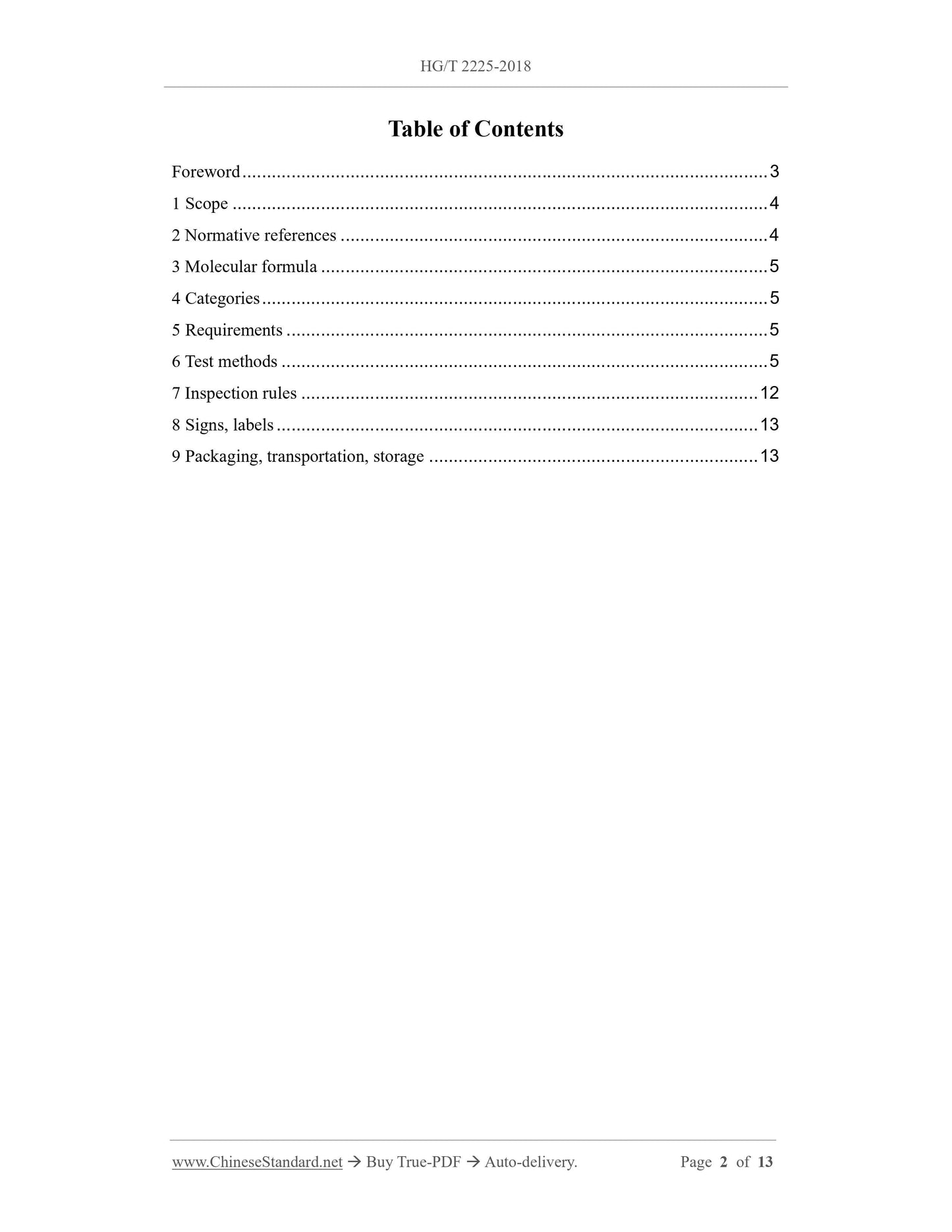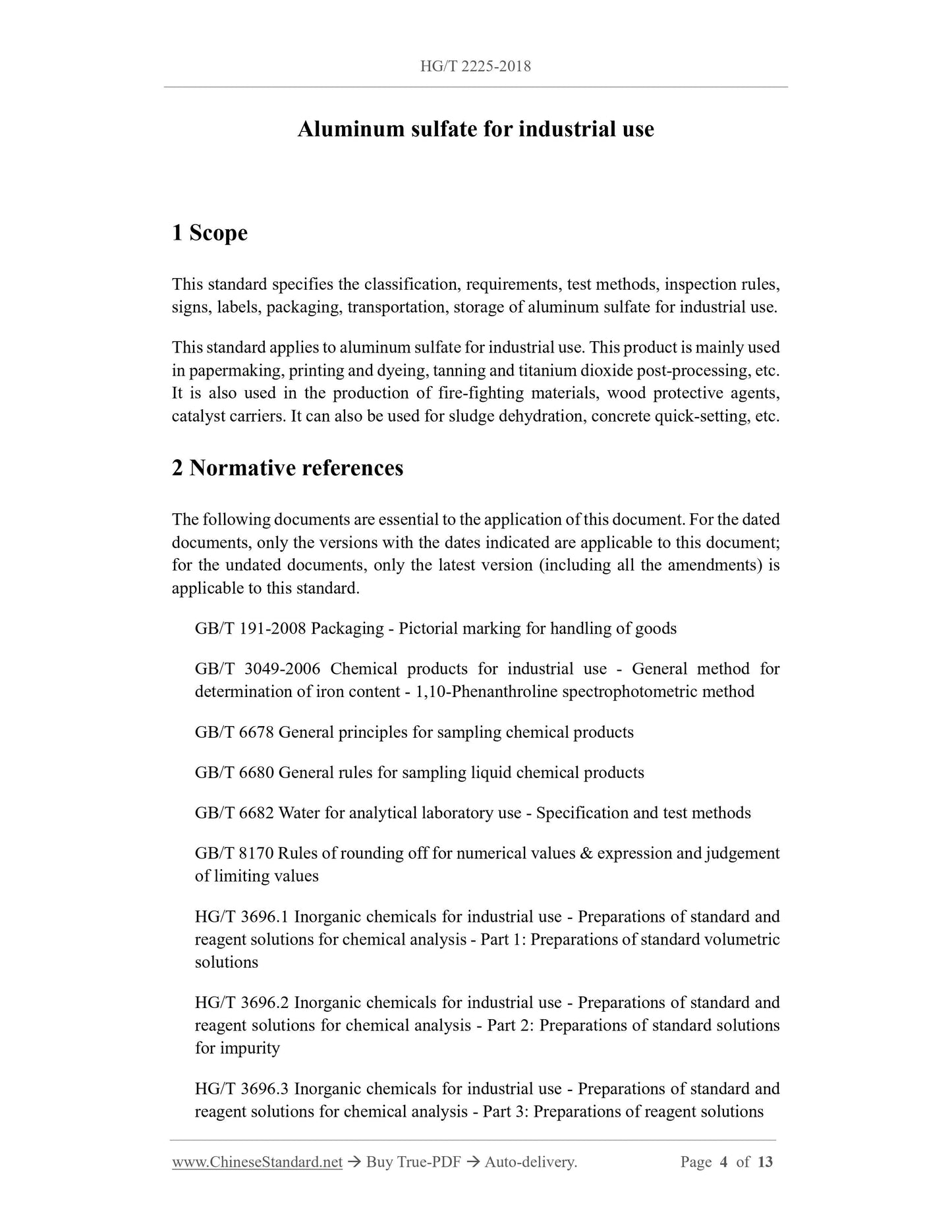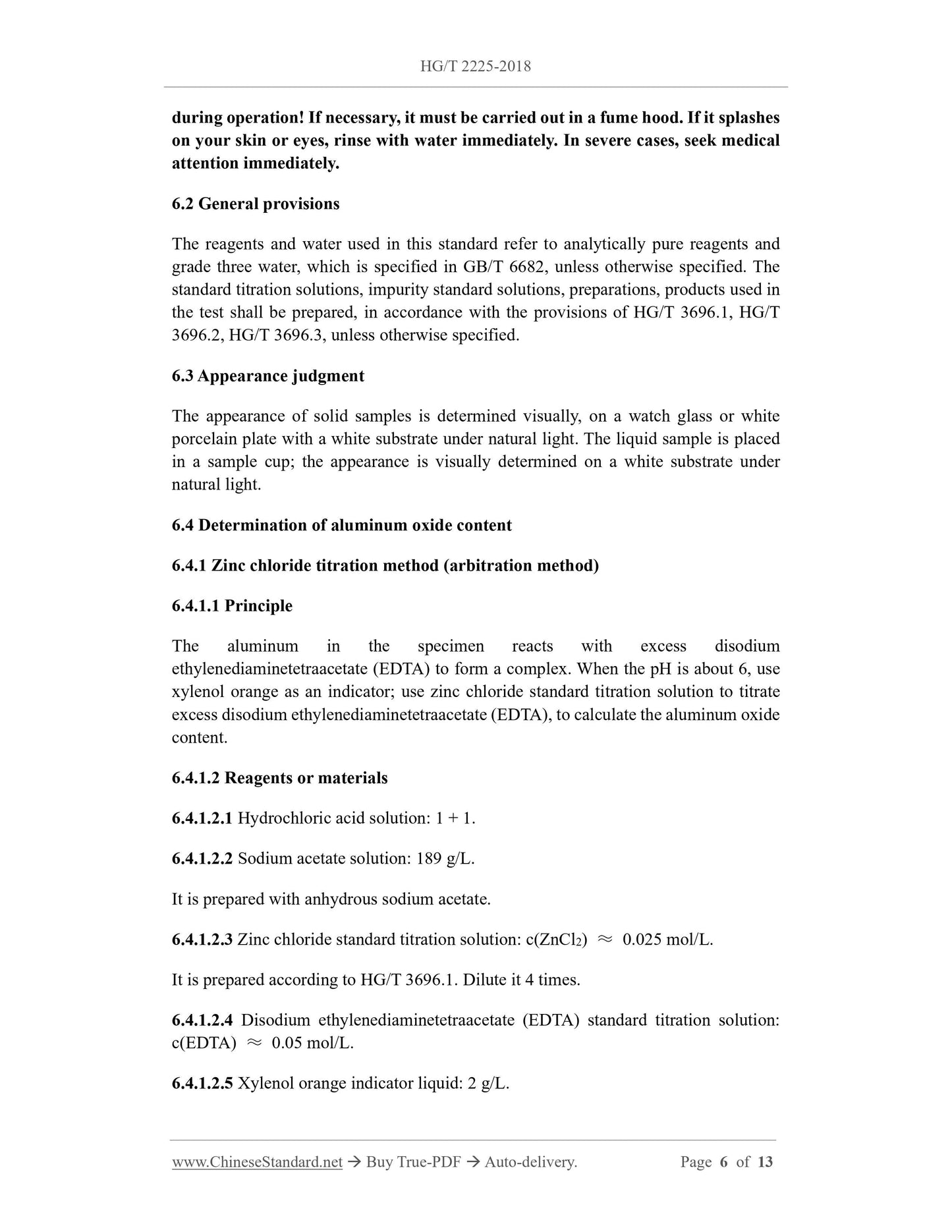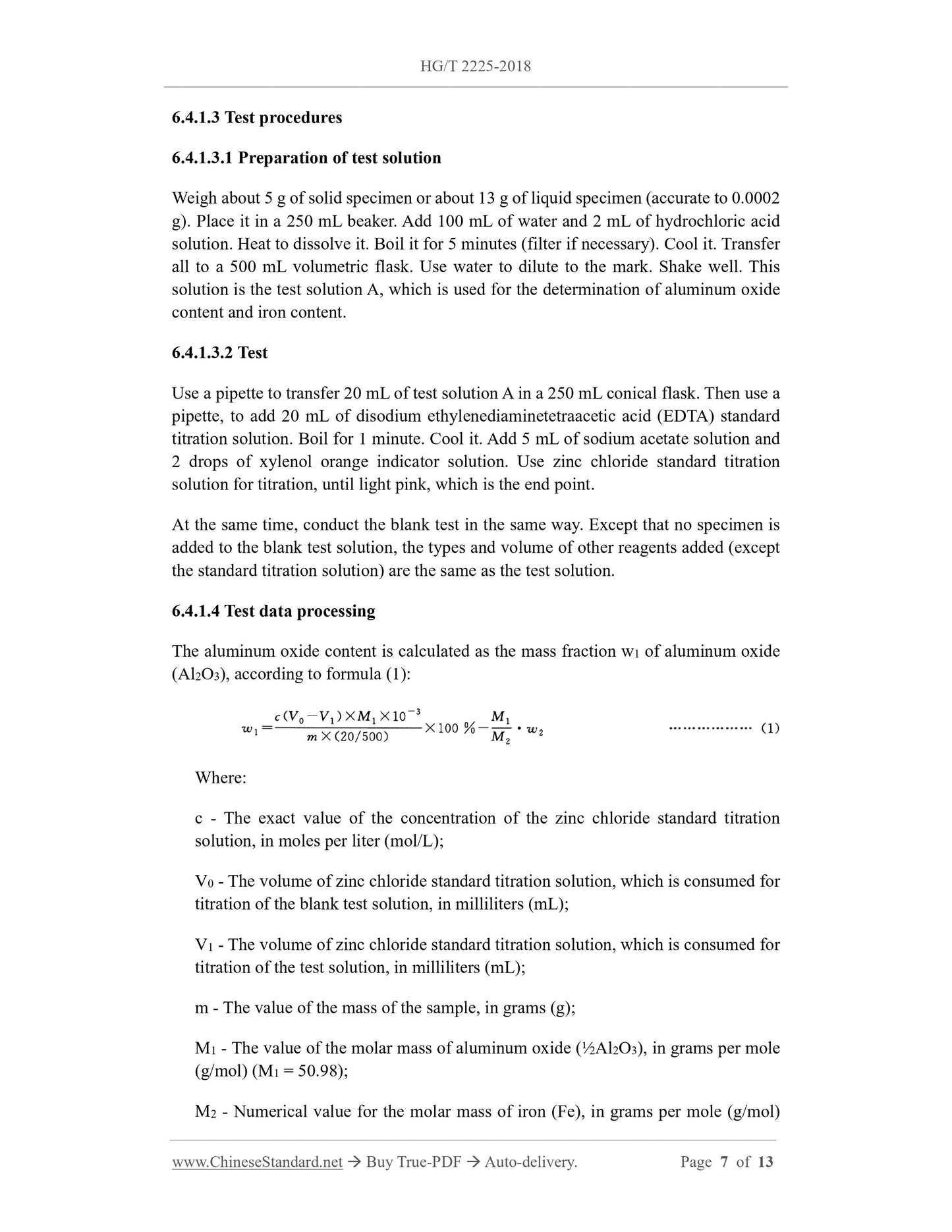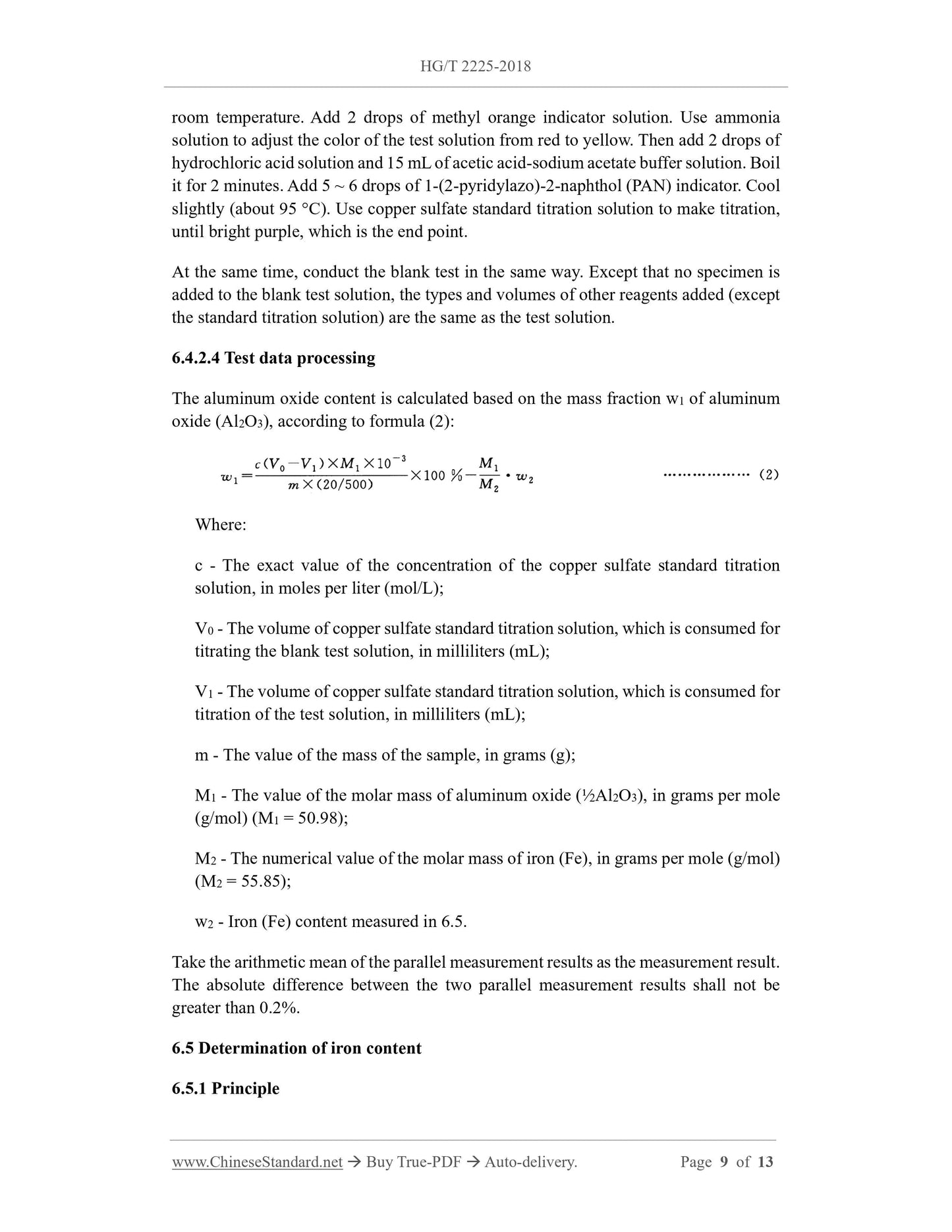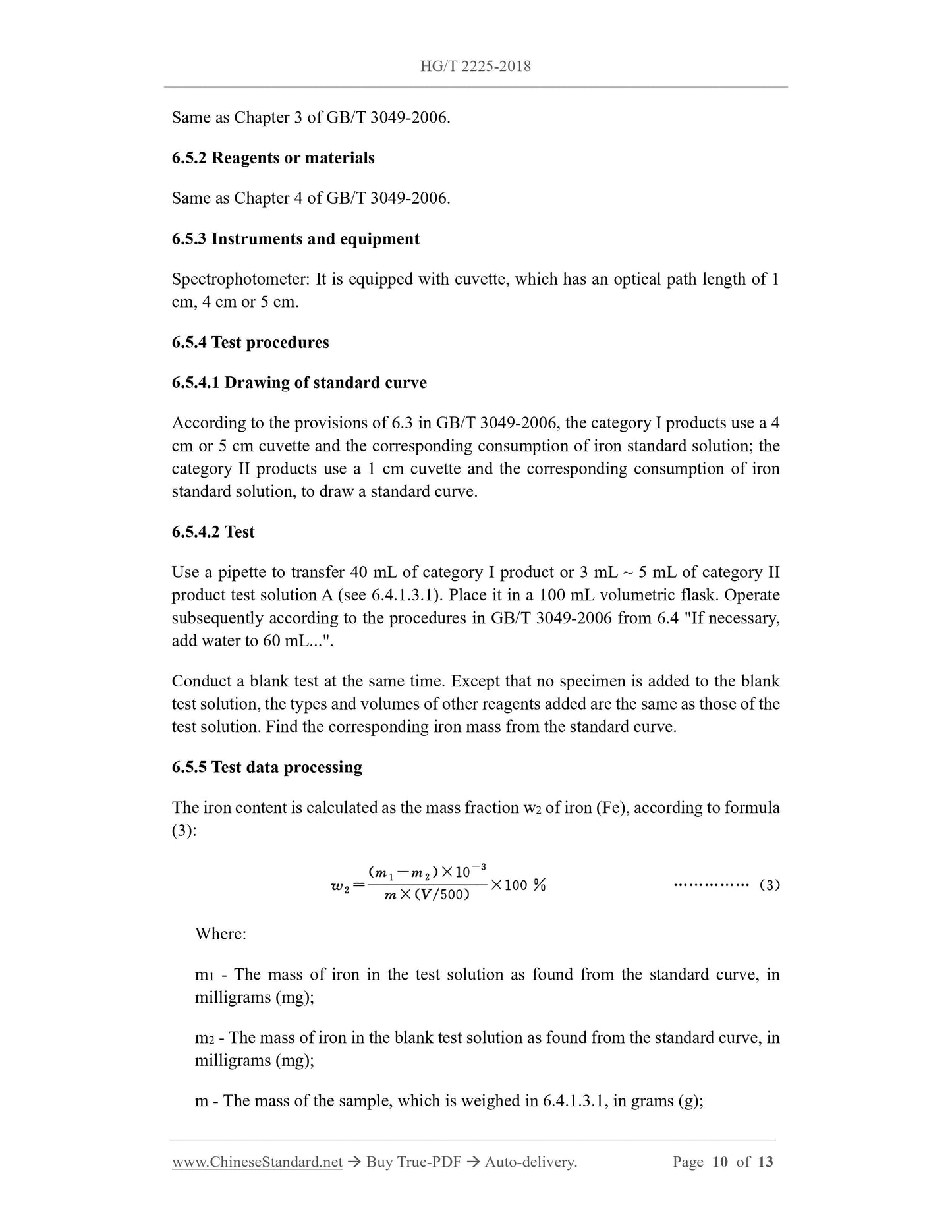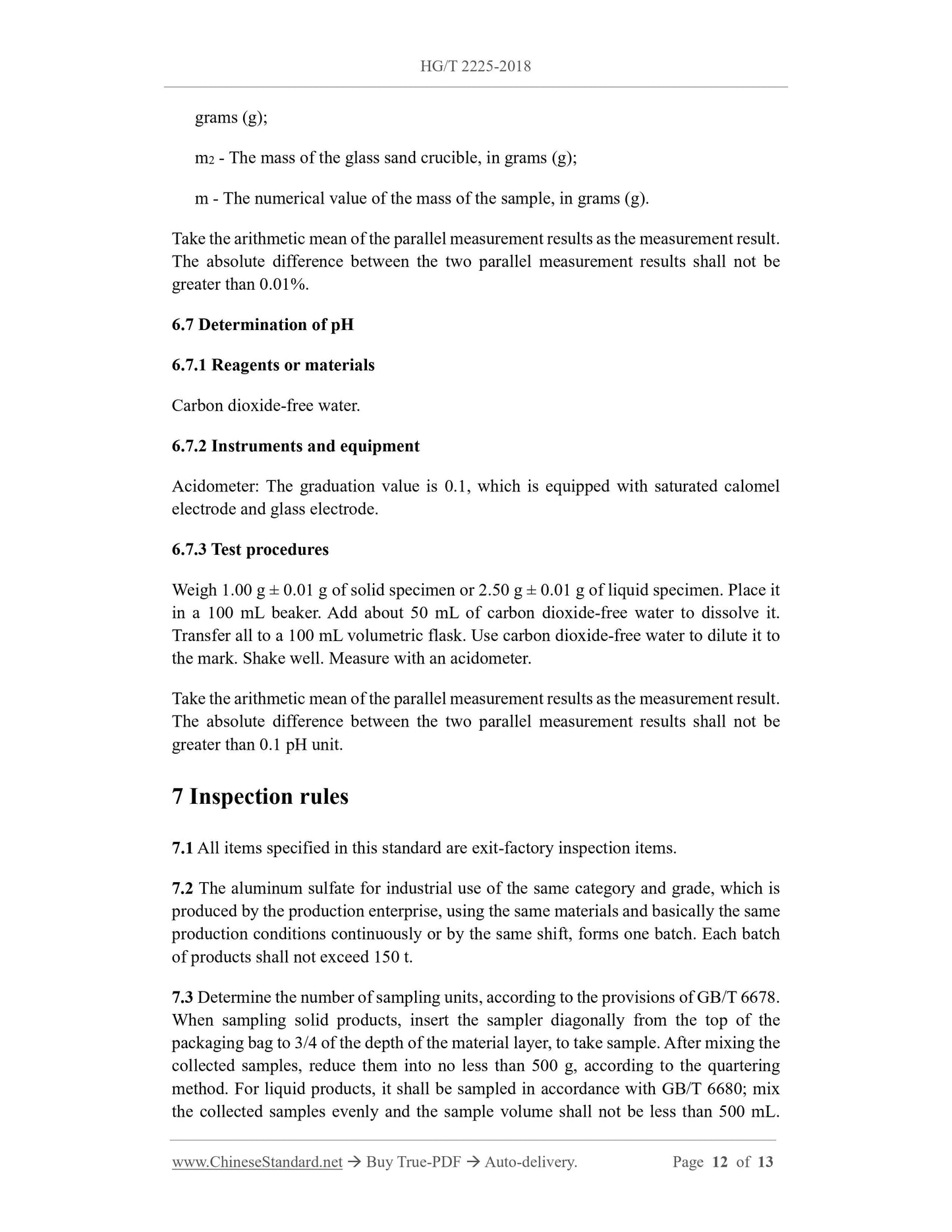1
/
of
8
www.ChineseStandard.us -- Field Test Asia Pte. Ltd.
HG/T 2225-2018 English PDF (HG/T2225-2018)
HG/T 2225-2018 English PDF (HG/T2225-2018)
Regular price
$185.00
Regular price
Sale price
$185.00
Unit price
/
per
Shipping calculated at checkout.
Couldn't load pickup availability
HG/T 2225-2018: Aluminum sulfate for industrial use
Delivery: 9 seconds. Download (& Email) true-PDF + Invoice.
Get Quotation: Click HG/T 2225-2018 (Self-service in 1-minute)
Historical versions (Master-website): HG/T 2225-2018
Preview True-PDF (Reload/Scroll-down if blank)
HG/T 2225-2018
HG
CHEMICAL INDUSTRY STANDARD OF
THE PEOPLE’S REPUBLIC OF CHINA
ICS 71.060.50
G 12
Filing No.: 65289-2018
Replacing HG/T 2225-2010
Aluminum sulfate for industrial use
工业硫酸铝
ISSUED ON: OCTOBER 22, 2018
IMPLEMENTED ON: APRIL 01, 2019
Issued by: Ministry of Industry and Information Technology of PRC
Table of Contents
Foreword ... 3
1 Scope ... 4
2 Normative references ... 4
3 Molecular formula ... 5
4 Categories ... 5
5 Requirements ... 5
6 Test methods ... 5
7 Inspection rules ... 12
8 Signs, labels ... 13
9 Packaging, transportation, storage ... 13
Aluminum sulfate for industrial use
1 Scope
This standard specifies the classification, requirements, test methods, inspection rules,
signs, labels, packaging, transportation, storage of aluminum sulfate for industrial use.
This standard applies to aluminum sulfate for industrial use. This product is mainly used
in papermaking, printing and dyeing, tanning and titanium dioxide post-processing, etc.
It is also used in the production of fire-fighting materials, wood protective agents,
catalyst carriers. It can also be used for sludge dehydration, concrete quick-setting, etc.
2 Normative references
The following documents are essential to the application of this document. For the dated
documents, only the versions with the dates indicated are applicable to this document;
for the undated documents, only the latest version (including all the amendments) is
applicable to this standard.
GB/T 191-2008 Packaging - Pictorial marking for handling of goods
GB/T 3049-2006 Chemical products for industrial use - General method for
determination of iron content - 1,10-Phenanthroline spectrophotometric method
GB/T 6678 General principles for sampling chemical products
GB/T 6680 General rules for sampling liquid chemical products
GB/T 6682 Water for analytical laboratory use - Specification and test methods
GB/T 8170 Rules of rounding off for numerical values and expression and judgement
of limiting values
HG/T 3696.1 Inorganic chemicals for industrial use - Preparations of standard and
reagent solutions for chemical analysis - Part 1: Preparations of standard volumetric
solutions
HG/T 3696.2 Inorganic chemicals for industrial use - Preparations of standard and
reagent solutions for chemical analysis - Part 2: Preparations of standard solutions
for impurity
HG/T 3696.3 Inorganic chemicals for industrial use - Preparations of standard and
reagent solutions for chemical analysis - Part 3: Preparations of reagent solutions
during operation! If necessary, it must be carried out in a fume hood. If it splashes
on your skin or eyes, rinse with water immediately. In severe cases, seek medical
attention immediately.
6.2 General provisions
The reagents and water used in this standard refer to analytically pure reagents and
grade three water, which is specified in GB/T 6682, unless otherwise specified. The
standard titration solutions, impurity standard solutions, preparations, products used in
the test shall be prepared, in accordance with the provisions of HG/T 3696.1, HG/T
3696.2, HG/T 3696.3, unless otherwise specified.
6.3 Appearance judgment
The appearance of solid samples is determined visually, on a watch glass or white
porcelain plate with a white substrate under natural light. The liquid sample is placed
in a sample cup; the appearance is visually determined on a white substrate under
natural light.
6.4 Determination of aluminum oxide content
6.4.1 Zinc chloride titration method (arbitration method)
6.4.1.1 Principle
The aluminum in the specimen reacts with excess disodium
ethylenediaminetetraacetate (EDTA) to form a complex. When the pH is about 6, use
xylenol orange as an indicator; use zinc chloride standard titration solution to titrate
excess disodium ethylenediaminetetraacetate (EDTA), to calculate the aluminum oxide
content.
6.4.1.2 Reagents or materials
6.4.1.2.1 Hydrochloric acid solution: 1 + 1.
6.4.1.2.2 Sodium acetate solution: 189 g/L.
It is prepared with anhydrous sodium acetate.
6.4.1.2.3 Zinc chloride standard titration solution: c(ZnCl2) ≈ 0.025 mol/L.
It is prepared according to HG/T 3696.1. Dilute it 4 times.
6.4.1.2.4 Disodium ethylenediaminetetraacetate (EDTA) standard titration solution:
c(EDTA) ≈ 0.05 mol/L.
6.4.1.2.5 Xylenol orange indicator liquid: 2 g/L.
6.4.1.3 Test procedures
6.4.1.3.1 Preparation of test solution
Weigh about 5 g of solid specimen or about 13 g of liquid specimen (accurate to 0.0002
g). Place it in a 250 mL beaker. Add 100 mL of water and 2 mL of hydrochloric acid
solution. Heat to dissolve it. Boil it for 5 minutes (filter if necessary). Cool it. Transfer
all to a 500 mL volumetric flask. Use water to dilute to the mark. Shake well. This
solution is the test solution A, which is used for the determination of aluminum oxide
content and iron content.
6.4.1.3.2 Test
Use a pipette to transfer 20 mL of test solution A in a 250 mL conical flask. Then use a
pipette, to add 20 mL of disodium ethylenediaminetetraacetic acid (EDTA) standard
titration solution. Boil for 1 minute. Cool it. Add 5 mL of sodium acetate solution and
2 drops of xylenol orange indicator solution. Use zinc chloride standard titration
solution for titration, until light pink, which is the end point.
At the same time, conduct the blank test in the same way. Except that no specimen is
added to the blank test solution, the types and volume of other reagents added (except
the standard titration solution) are the same as the test solution.
6.4.1.4 Test data processing
The aluminum oxide content is calculated as the mass fraction w1 of aluminum oxide
(Al2O3), according to formula (1):
Where:
c - The exact value of the concentration of the zinc chloride standard titration
solution, in moles per liter (mol/L);
V0 - The volume of zinc chloride standard titration solution, which is consumed for
titration of the blank test solution, in milliliters (mL);
V1 - The volume of zinc chloride standard titration solution, which is consumed for
titration of the test solution, in milliliters (mL);
m - The value of the mass of the sample, in grams (g);
M1 - The value of the molar mass of aluminum oxide (⅟2Al2O3), in grams per mole
(g/mol) (M1 = 50.98);
M2 - Numerical value for the molar mass of iron (Fe), in grams per mole (g/mol)
room temperature. Add 2 drops of methyl orange indicator solution. Use ammonia
solution to adjust the color of the test solution from red to yellow. Then add 2 drops of
hydrochloric acid solution and 15 mL of acetic acid-sodium acetate buffer solution. Boil
it for 2 minutes. Add 5 ~ 6 drops of 1-(2-pyridylazo)-2-naphthol (PAN) indicator. Cool
slightly (about 95 °C). Use copper sulfate standard titration solution to make titration,
until bright purple, which is the end point.
At the same time, conduct the blank test in the same way. Except that no specimen is
added to the blank test solution, the types and volumes of other reagents added (except
the standard titration solution) are the same as the test solution.
6.4.2.4 Test data processing
The aluminum oxide content is calculated based on the mass fraction w1 of aluminum
oxide (Al2O3), according to formula (2):
Where:
c - The exact value of the concentration of the copper sulfate standard titration
solution, in moles per liter (mol/L);
V0 - The volume of copper sulfate standard titration solution, which is consumed for
titrating the blank test solution, in milliliters (mL);
V1 - The volume of copper sulfate standard titration solution, which is consumed for
titration of the test solution, in milliliters (mL);
m - The value of the mass of the sample, in grams (g);
M1 - The value of the molar mass of aluminum oxide (⅟2Al2O3), in grams per mole
(g/mol) (M1 = 50.98);
M2 - The numerical value of the molar mass of iron (Fe), in grams per mole (g/mol)
(M2 = 55.85);
w2 - Iron (Fe) content measured in 6.5.
Take the arithmetic mean of the parallel measurement results as the measurement result.
The absolute difference between the two parallel measurement results shall not be
greater than 0.2%.
6.5 Determination of iron content
6.5.1 Principle
Same as Chapter 3 of GB/T 3049-2006.
6.5.2 Reagents or materials
Same as Chapter 4 of GB/T 3049-2006.
6.5.3 Instruments and equipment
Spectrophotometer: It is equipped with cuvette, which has an optical path length of 1
cm, 4 cm or 5 cm.
6.5.4 Test procedures
6.5.4.1 Drawing of standard curve
According to the provisions of 6.3 in GB/T 3049-2006, the category I products use a 4
cm or 5 cm cuvette and the corresponding consumption of iron standard solution; the
category II products use a 1 cm cuvette and the corresponding consumption of iron
standard solution, to draw a standard curve.
6.5.4.2 Test
Use a pipette to transfer 40 mL of category I product or 3 mL ~ 5 mL of category II
product test solution A (see 6.4.1.3.1). Place it in a 100 mL volumetric flask. Operate
subsequently according to the procedures in GB/T 3049-2006 from 6.4 "If necessary,
add water to 60 mL...".
Conduct a blank test at the same time. Except that no specimen is added to the blank
test solution, the types and volumes of other reagents added are the same as those of the
test solution. Find the corresponding iron mass from the standard curve.
6.5.5 Test data processing
The iron content is calculated as the mass fraction w2 of iron (Fe), according to formula
(3):
Where:
m1 - The mass of iron in the test solution as found from the standard curve, in
milligrams (mg);
m2 - The mass of iron in the blank test solution as found from the standard curve, in
milligrams (mg);
m - The mass of the sample, which is weighed in 6.4.1.3.1, in grams (g);
grams (g);
m2 - The mass of the glass sand crucible, in grams (g);
m - The numerical value of the mass of the sample, in grams (g).
Take the arithmetic mean of the parallel measurement results as the measurement result.
The absolute difference between the two parallel measurement results shall not be
greater than 0.01%.
6.7 Determination of pH
6.7.1 Reagents or materials
Carbon dioxide-free water.
6.7.2 Instruments and equipment
Acidometer: The graduation value is 0.1, which is equipped with saturated calomel
electrode and glass electrode.
6.7.3 Test procedures
Weigh 1.00 g ± 0.01 g of solid specimen or 2.50 g ± 0.01 g of liquid specimen. Place it
in a 100 mL beaker. Add about 50 mL of carbon dioxide-free water to dissolve it.
Transfer all to a 100 mL volumetric flask. Use carbon dioxide-free water to dilute it to
the mark. Shake well. Measure with an acidometer.
Take the arithmetic mean of the parallel measurement results as the measurement result.
The absolute difference between the two parallel measurement results shall not be
greater than 0.1 pH unit.
7 Inspection rules
7.1 All items specified in this standard are exit-factory inspection items.
7.2 The aluminum sulfate for industrial use of the same category and grade, which is
produced by the production enterprise, using the same materials and basically the same
production conditions continuously or by the same shift, forms one batch. Each batch
of products shall not exceed 150 t.
7.3 Determine the number of sampling units, according to the provisions of GB/T 6678.
When sampling solid products, insert the sampler diagonally from the top of the
packaging bag to 3/4 of the depth of the material layer, to take sample. After mixing the
collected samples, reduce them into no less than 500 g, according to the quartering
method. For liquid products, it shall be sampled in accordance with GB/T 6680; mix
the collected samples evenly and the sample volume shall not be less than 500 mL.
HG/T 2225-2018
HG
CHEMICAL INDUSTRY STANDARD OF
THE PEOPLE’S REPUBLIC OF CHINA
ICS 71.060.50
G 12
Filing No.: 65289-2018
Replacing HG/T 2225-2010
Aluminum sulfate for industrial use
工业硫酸铝
ISSUED ON: OCTOBER 22, 2018
IMPLEMENTED ON: APRIL 01, 2019
Issued by: Ministry of Industry and Information Technology of PRC
Table of Contents
Foreword ... 3
1 Scope ... 4
2 Normative references ... 4
3 Molecular formula ... 5
4 Categories ... 5
5 Requirements ... 5
6 Test methods ... 5
7 Inspection rules ... 12
8 Signs, labels ... 13
9 Packaging, transportation, storage ... 13
Aluminum sulfate for industrial use
1 Scope
This standard specifies the classification, requirements, test methods, inspection rules,
signs, labels, packaging, transportation, storage of aluminum sulfate for industrial use.
This standard applies to aluminum sulfate for industrial use. This product is mainly used
in papermaking, printing and dyeing, tanning and titanium dioxide post-processing, etc.
It is also used in the production of fire-fighting materials, wood protective agents,
catalyst carriers. It can also be used for sludge dehydration, concrete quick-setting, etc.
2 Normative references
The following documents are essential to the application of this document. For the dated
documents, only the versions with the dates indicated are applicable to this document;
for the undated documents, only the latest version (including all the amendments) is
applicable to this standard.
GB/T 191-2008 Packaging - Pictorial marking for handling of goods
GB/T 3049-2006 Chemical products for industrial use - General method for
determination of iron content - 1,10-Phenanthroline spectrophotometric method
GB/T 6678 General principles for sampling chemical products
GB/T 6680 General rules for sampling liquid chemical products
GB/T 6682 Water for analytical laboratory use - Specification and test methods
GB/T 8170 Rules of rounding off for numerical values and expression and judgement
of limiting values
HG/T 3696.1 Inorganic chemicals for industrial use - Preparations of standard and
reagent solutions for chemical analysis - Part 1: Preparations of standard volumetric
sol...
Delivery: 9 seconds. Download (& Email) true-PDF + Invoice.
Get Quotation: Click HG/T 2225-2018 (Self-service in 1-minute)
Historical versions (Master-website): HG/T 2225-2018
Preview True-PDF (Reload/Scroll-down if blank)
HG/T 2225-2018
HG
CHEMICAL INDUSTRY STANDARD OF
THE PEOPLE’S REPUBLIC OF CHINA
ICS 71.060.50
G 12
Filing No.: 65289-2018
Replacing HG/T 2225-2010
Aluminum sulfate for industrial use
工业硫酸铝
ISSUED ON: OCTOBER 22, 2018
IMPLEMENTED ON: APRIL 01, 2019
Issued by: Ministry of Industry and Information Technology of PRC
Table of Contents
Foreword ... 3
1 Scope ... 4
2 Normative references ... 4
3 Molecular formula ... 5
4 Categories ... 5
5 Requirements ... 5
6 Test methods ... 5
7 Inspection rules ... 12
8 Signs, labels ... 13
9 Packaging, transportation, storage ... 13
Aluminum sulfate for industrial use
1 Scope
This standard specifies the classification, requirements, test methods, inspection rules,
signs, labels, packaging, transportation, storage of aluminum sulfate for industrial use.
This standard applies to aluminum sulfate for industrial use. This product is mainly used
in papermaking, printing and dyeing, tanning and titanium dioxide post-processing, etc.
It is also used in the production of fire-fighting materials, wood protective agents,
catalyst carriers. It can also be used for sludge dehydration, concrete quick-setting, etc.
2 Normative references
The following documents are essential to the application of this document. For the dated
documents, only the versions with the dates indicated are applicable to this document;
for the undated documents, only the latest version (including all the amendments) is
applicable to this standard.
GB/T 191-2008 Packaging - Pictorial marking for handling of goods
GB/T 3049-2006 Chemical products for industrial use - General method for
determination of iron content - 1,10-Phenanthroline spectrophotometric method
GB/T 6678 General principles for sampling chemical products
GB/T 6680 General rules for sampling liquid chemical products
GB/T 6682 Water for analytical laboratory use - Specification and test methods
GB/T 8170 Rules of rounding off for numerical values and expression and judgement
of limiting values
HG/T 3696.1 Inorganic chemicals for industrial use - Preparations of standard and
reagent solutions for chemical analysis - Part 1: Preparations of standard volumetric
solutions
HG/T 3696.2 Inorganic chemicals for industrial use - Preparations of standard and
reagent solutions for chemical analysis - Part 2: Preparations of standard solutions
for impurity
HG/T 3696.3 Inorganic chemicals for industrial use - Preparations of standard and
reagent solutions for chemical analysis - Part 3: Preparations of reagent solutions
during operation! If necessary, it must be carried out in a fume hood. If it splashes
on your skin or eyes, rinse with water immediately. In severe cases, seek medical
attention immediately.
6.2 General provisions
The reagents and water used in this standard refer to analytically pure reagents and
grade three water, which is specified in GB/T 6682, unless otherwise specified. The
standard titration solutions, impurity standard solutions, preparations, products used in
the test shall be prepared, in accordance with the provisions of HG/T 3696.1, HG/T
3696.2, HG/T 3696.3, unless otherwise specified.
6.3 Appearance judgment
The appearance of solid samples is determined visually, on a watch glass or white
porcelain plate with a white substrate under natural light. The liquid sample is placed
in a sample cup; the appearance is visually determined on a white substrate under
natural light.
6.4 Determination of aluminum oxide content
6.4.1 Zinc chloride titration method (arbitration method)
6.4.1.1 Principle
The aluminum in the specimen reacts with excess disodium
ethylenediaminetetraacetate (EDTA) to form a complex. When the pH is about 6, use
xylenol orange as an indicator; use zinc chloride standard titration solution to titrate
excess disodium ethylenediaminetetraacetate (EDTA), to calculate the aluminum oxide
content.
6.4.1.2 Reagents or materials
6.4.1.2.1 Hydrochloric acid solution: 1 + 1.
6.4.1.2.2 Sodium acetate solution: 189 g/L.
It is prepared with anhydrous sodium acetate.
6.4.1.2.3 Zinc chloride standard titration solution: c(ZnCl2) ≈ 0.025 mol/L.
It is prepared according to HG/T 3696.1. Dilute it 4 times.
6.4.1.2.4 Disodium ethylenediaminetetraacetate (EDTA) standard titration solution:
c(EDTA) ≈ 0.05 mol/L.
6.4.1.2.5 Xylenol orange indicator liquid: 2 g/L.
6.4.1.3 Test procedures
6.4.1.3.1 Preparation of test solution
Weigh about 5 g of solid specimen or about 13 g of liquid specimen (accurate to 0.0002
g). Place it in a 250 mL beaker. Add 100 mL of water and 2 mL of hydrochloric acid
solution. Heat to dissolve it. Boil it for 5 minutes (filter if necessary). Cool it. Transfer
all to a 500 mL volumetric flask. Use water to dilute to the mark. Shake well. This
solution is the test solution A, which is used for the determination of aluminum oxide
content and iron content.
6.4.1.3.2 Test
Use a pipette to transfer 20 mL of test solution A in a 250 mL conical flask. Then use a
pipette, to add 20 mL of disodium ethylenediaminetetraacetic acid (EDTA) standard
titration solution. Boil for 1 minute. Cool it. Add 5 mL of sodium acetate solution and
2 drops of xylenol orange indicator solution. Use zinc chloride standard titration
solution for titration, until light pink, which is the end point.
At the same time, conduct the blank test in the same way. Except that no specimen is
added to the blank test solution, the types and volume of other reagents added (except
the standard titration solution) are the same as the test solution.
6.4.1.4 Test data processing
The aluminum oxide content is calculated as the mass fraction w1 of aluminum oxide
(Al2O3), according to formula (1):
Where:
c - The exact value of the concentration of the zinc chloride standard titration
solution, in moles per liter (mol/L);
V0 - The volume of zinc chloride standard titration solution, which is consumed for
titration of the blank test solution, in milliliters (mL);
V1 - The volume of zinc chloride standard titration solution, which is consumed for
titration of the test solution, in milliliters (mL);
m - The value of the mass of the sample, in grams (g);
M1 - The value of the molar mass of aluminum oxide (⅟2Al2O3), in grams per mole
(g/mol) (M1 = 50.98);
M2 - Numerical value for the molar mass of iron (Fe), in grams per mole (g/mol)
room temperature. Add 2 drops of methyl orange indicator solution. Use ammonia
solution to adjust the color of the test solution from red to yellow. Then add 2 drops of
hydrochloric acid solution and 15 mL of acetic acid-sodium acetate buffer solution. Boil
it for 2 minutes. Add 5 ~ 6 drops of 1-(2-pyridylazo)-2-naphthol (PAN) indicator. Cool
slightly (about 95 °C). Use copper sulfate standard titration solution to make titration,
until bright purple, which is the end point.
At the same time, conduct the blank test in the same way. Except that no specimen is
added to the blank test solution, the types and volumes of other reagents added (except
the standard titration solution) are the same as the test solution.
6.4.2.4 Test data processing
The aluminum oxide content is calculated based on the mass fraction w1 of aluminum
oxide (Al2O3), according to formula (2):
Where:
c - The exact value of the concentration of the copper sulfate standard titration
solution, in moles per liter (mol/L);
V0 - The volume of copper sulfate standard titration solution, which is consumed for
titrating the blank test solution, in milliliters (mL);
V1 - The volume of copper sulfate standard titration solution, which is consumed for
titration of the test solution, in milliliters (mL);
m - The value of the mass of the sample, in grams (g);
M1 - The value of the molar mass of aluminum oxide (⅟2Al2O3), in grams per mole
(g/mol) (M1 = 50.98);
M2 - The numerical value of the molar mass of iron (Fe), in grams per mole (g/mol)
(M2 = 55.85);
w2 - Iron (Fe) content measured in 6.5.
Take the arithmetic mean of the parallel measurement results as the measurement result.
The absolute difference between the two parallel measurement results shall not be
greater than 0.2%.
6.5 Determination of iron content
6.5.1 Principle
Same as Chapter 3 of GB/T 3049-2006.
6.5.2 Reagents or materials
Same as Chapter 4 of GB/T 3049-2006.
6.5.3 Instruments and equipment
Spectrophotometer: It is equipped with cuvette, which has an optical path length of 1
cm, 4 cm or 5 cm.
6.5.4 Test procedures
6.5.4.1 Drawing of standard curve
According to the provisions of 6.3 in GB/T 3049-2006, the category I products use a 4
cm or 5 cm cuvette and the corresponding consumption of iron standard solution; the
category II products use a 1 cm cuvette and the corresponding consumption of iron
standard solution, to draw a standard curve.
6.5.4.2 Test
Use a pipette to transfer 40 mL of category I product or 3 mL ~ 5 mL of category II
product test solution A (see 6.4.1.3.1). Place it in a 100 mL volumetric flask. Operate
subsequently according to the procedures in GB/T 3049-2006 from 6.4 "If necessary,
add water to 60 mL...".
Conduct a blank test at the same time. Except that no specimen is added to the blank
test solution, the types and volumes of other reagents added are the same as those of the
test solution. Find the corresponding iron mass from the standard curve.
6.5.5 Test data processing
The iron content is calculated as the mass fraction w2 of iron (Fe), according to formula
(3):
Where:
m1 - The mass of iron in the test solution as found from the standard curve, in
milligrams (mg);
m2 - The mass of iron in the blank test solution as found from the standard curve, in
milligrams (mg);
m - The mass of the sample, which is weighed in 6.4.1.3.1, in grams (g);
grams (g);
m2 - The mass of the glass sand crucible, in grams (g);
m - The numerical value of the mass of the sample, in grams (g).
Take the arithmetic mean of the parallel measurement results as the measurement result.
The absolute difference between the two parallel measurement results shall not be
greater than 0.01%.
6.7 Determination of pH
6.7.1 Reagents or materials
Carbon dioxide-free water.
6.7.2 Instruments and equipment
Acidometer: The graduation value is 0.1, which is equipped with saturated calomel
electrode and glass electrode.
6.7.3 Test procedures
Weigh 1.00 g ± 0.01 g of solid specimen or 2.50 g ± 0.01 g of liquid specimen. Place it
in a 100 mL beaker. Add about 50 mL of carbon dioxide-free water to dissolve it.
Transfer all to a 100 mL volumetric flask. Use carbon dioxide-free water to dilute it to
the mark. Shake well. Measure with an acidometer.
Take the arithmetic mean of the parallel measurement results as the measurement result.
The absolute difference between the two parallel measurement results shall not be
greater than 0.1 pH unit.
7 Inspection rules
7.1 All items specified in this standard are exit-factory inspection items.
7.2 The aluminum sulfate for industrial use of the same category and grade, which is
produced by the production enterprise, using the same materials and basically the same
production conditions continuously or by the same shift, forms one batch. Each batch
of products shall not exceed 150 t.
7.3 Determine the number of sampling units, according to the provisions of GB/T 6678.
When sampling solid products, insert the sampler diagonally from the top of the
packaging bag to 3/4 of the depth of the material layer, to take sample. After mixing the
collected samples, reduce them into no less than 500 g, according to the quartering
method. For liquid products, it shall be sampled in accordance with GB/T 6680; mix
the collected samples evenly and the sample volume shall not be less than 500 mL.
HG/T 2225-2018
HG
CHEMICAL INDUSTRY STANDARD OF
THE PEOPLE’S REPUBLIC OF CHINA
ICS 71.060.50
G 12
Filing No.: 65289-2018
Replacing HG/T 2225-2010
Aluminum sulfate for industrial use
工业硫酸铝
ISSUED ON: OCTOBER 22, 2018
IMPLEMENTED ON: APRIL 01, 2019
Issued by: Ministry of Industry and Information Technology of PRC
Table of Contents
Foreword ... 3
1 Scope ... 4
2 Normative references ... 4
3 Molecular formula ... 5
4 Categories ... 5
5 Requirements ... 5
6 Test methods ... 5
7 Inspection rules ... 12
8 Signs, labels ... 13
9 Packaging, transportation, storage ... 13
Aluminum sulfate for industrial use
1 Scope
This standard specifies the classification, requirements, test methods, inspection rules,
signs, labels, packaging, transportation, storage of aluminum sulfate for industrial use.
This standard applies to aluminum sulfate for industrial use. This product is mainly used
in papermaking, printing and dyeing, tanning and titanium dioxide post-processing, etc.
It is also used in the production of fire-fighting materials, wood protective agents,
catalyst carriers. It can also be used for sludge dehydration, concrete quick-setting, etc.
2 Normative references
The following documents are essential to the application of this document. For the dated
documents, only the versions with the dates indicated are applicable to this document;
for the undated documents, only the latest version (including all the amendments) is
applicable to this standard.
GB/T 191-2008 Packaging - Pictorial marking for handling of goods
GB/T 3049-2006 Chemical products for industrial use - General method for
determination of iron content - 1,10-Phenanthroline spectrophotometric method
GB/T 6678 General principles for sampling chemical products
GB/T 6680 General rules for sampling liquid chemical products
GB/T 6682 Water for analytical laboratory use - Specification and test methods
GB/T 8170 Rules of rounding off for numerical values and expression and judgement
of limiting values
HG/T 3696.1 Inorganic chemicals for industrial use - Preparations of standard and
reagent solutions for chemical analysis - Part 1: Preparations of standard volumetric
sol...
Share

